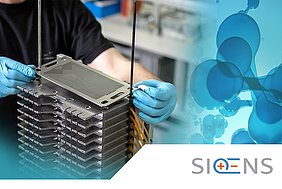
The cost-effective transportation of hydrogen remains a major challenge in the build-up of the hydrogen economy. The existing natural gas network with a total length of 550,000 km presents an interesting basis for large-scale distribution. This has been recently confirmed by a study conducted by the Materials Testing Institute of the University of Stuttgart, according to which the steel pipelines installed in the German gas network are well suited for the transport of hydrogen.
Using existing pipeline infrastructure in the distribution of hydrogen
To date, there is a technical standard in Germany that limits the admixture of hydrogen in the natural gas network to a maximum of 10 percent. According to the German Technical and Scientific Association for Gas and Water (DVGW), the existing gas infrastructure can gradually be upgraded to increase the proportion of hydrogen to up to 20 percent. In the long term, a partial conversion of the natural gas pipelines into the so-called European Hydrogen Backbone (EHB) is envisioned.
Regardless of whether hydrogen is fed into the existing natural gas network (blending) or transported via a pure hydrogen grid in the form of the EHB, a critical question arises: How is the hydrogen used and is it present in the required purity for downstream users?
Hydrogen quality is crucial for most applications
While hydrogen does not have to be specially processed for combustion, a large number of industrial consumers or fuel cells have high requirements regarding the purity of their hydrogen. Contamination and residual substances can have a negative impact on the efficiency and service life of the systems or impair production processes.
In case of future distribution of hydrogen via gas grid infrastructure, solutions for on-site purification are of corresponding importance. For example, the gas quality in the EHB is prospectively equivalent to Group A according to DVGW G260 and thus corresponds to a purity of 98%. For use as industrial gas or in fuel cells, however, hydrogen of Group D quality is required (> 99.97%).
Electrochemical hydrogen separation unlocks scalable processing of hydrogen
In this context, SIQENS electrochemical hydrogen separation (EHS) represents an attractive alternative to conventional hydrogen purification technologies such as pressure swing adsorption (also PSA) or membrane separation, as it requires relatively low energy consumption in combination with high selectivity for hydrogen.
Thus, it is also possible to separate hydrogen from gases with low hydrogen content, such as waste gases from industrial processes or blends in natural gas. As a scalable technology, EHS further represents an attractive solution for users with a modest consumption of hydrogen below 100 kg per day. On-site separation and purification allow the benefits of existing pipeline infrastructure to be leveraged in hydrogen distribution.
Meet us in Hall 4, Booth 210, at the joint-booth of Bayern Innovativ
About SIQENS:
SIQENS, founded 2012 in Munich, is a leading provider of methanol fuel cells and technology for electrochemical hydrogen separation (EHS). The Company’s methanol fuel cell product line (Ecoport) supplies clean energy in remote areas or backup power to critical applications. Built on its patented high-temperature polymer electrolyte membrane (HT-PEM) technology portfolio for power generation, SIQENS offers solutions to separate and purify hydrogen at the point of use from several feed gases – as from hydrogen-blends in natural gas pipelines or reformate gases from methanol or biogas. The SIQENS technology portfolio addresses the challenge of last-mile hydrogen distribution: Driving the decarbonization of power generation, transportation, and industry by reducing the cost of hydrogen delivery.
Pressekontakt:
SIQENS GmbH
Leon Schwarzott
Landsberger Str. 318 D
80687 Munich
+49 89 452 44 63 0